By Lucinda Reynolds | Photographed by Lucinda Reynolds
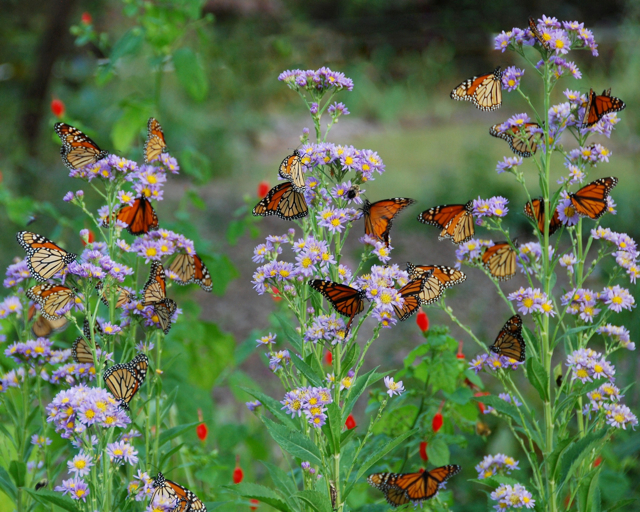

Because I’m a fairly lazy gardener who has planted far more than any sane gardener should, I grow minimal-care plants that thrive in our climate and soil conditions without coddling. When I select plants, I apply the guideline, “right plant, right place.” This adage keeps me from being lured into buying plants or seeds based mainly on their colorful foliage or blooms that seem to scream, “Choose ME!” Before I select any plant, I consider its sun, soil, fertilizer, water, and space needs, and whether or not my landscape and I meet these needs.
I could rattle on forever about all my favorite plants, but I am going to focus on cosmos and asters, two standouts for summer and fall color. Both are butterfly and beneficial insect magnets. I spread 2-3 inches of shredded wood mulch over 2 to 4 sheets of newspapers around plants to help conserve soil moisture and suppress weed growth.
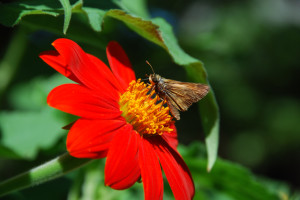
Colorful and Easy to Grow
Cosmos thrive in hot, dry areas with poor soil and are grown easily from seed, making an inexpensive addition to the garden. Cosmos (Cosmos sulphureus and Cosmos bipinnatus) thrive with minimal-care in sunny spots, blooming abundantly from June to frost when planted in full sun in average-to-poor soil. When planted in the shade, fertilized, watered too much or grown in fertile soil, cosmos grow into leggy plants with few blooms.
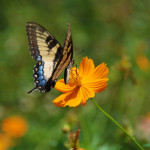
Cosmos sulphureus has gorgeous orange, yellow or orange-red flowers. The showy shorter cultivars, ‘Cosmic Red’ and ‘Cosmic Orange,’ show off best near the front of a sunny border. ‘Bright Lights’ fills the middle or back of the bed with 3-to 5-foot plants covered with bright 2- 3-inch blooms.
When orange or yellow flowers don’t suit a garden’s color scheme, I use Cosmos bipinnatus for its white, pink or lavender blossoms. Some of the cultivars have incredibly showy double and semi-double blooms. All cosmos add a special airiness to flower arrangements.
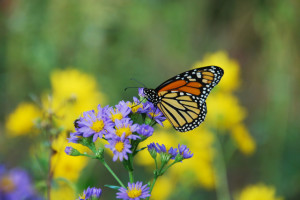
Asters: Fall Blooms & Butterflies
Aromatic aster (Aster oblongifolius) is one of my favorite minimal-care, easy-to-grow, fall-blooming Arkansas native perennial asters for full sun and dry-to-medium soil. Named for its aromatic foliage, the aromatic aster’s large sprays of purple blossoms brighten my fall garden. Remember “right plant, right place” when selecting its planting site because the aromatic aster will flop over in rich, fertile soil, or in too much shade. Although a shady yard or moist spot is not the right place for this particular aster, there are asters for those areas. Some of my other favorite plants such as cosmos, Tithonia rotundifolia (Mexican sunflower), ornamental peppers, butterfly weed, goldenrod ‘Fireworks’ and Rudbeckia create eye-catching displays when planted near asters. FYI: Just so I am not accused of recommending a plant that will irritate fellow gardeners’ nasal passages, eyes, and sinuses, experts state ragweed is the main culprit for causing hay fever, not goldenrod.
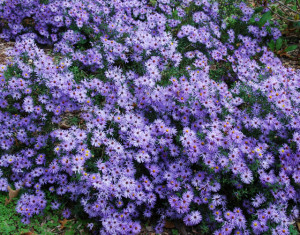
I plant aromatic asters because they add amazing fall color, and they help provide nectar required for fall migration of monarch butterflies. Certain female butterfly species (not monarchs) lay their eggs on asters. Specific plants, referred to as host plants, serve as food for the caterpillar until it reaches its chrysalis stage. Milkweeds (Ascletias) are the sole host plant for monarch larvae and make great aster companions.
The tatarian aster (Aster tataricus) thrives with neglect in heat and humidity. Each fall I am awed by the multitude of butterflies, bees, and other beneficial insects visiting ‘Jindai,’ my 4-foot tatarian aster cultivar. These asters need full sun, preferring well-drained soil with little or no fertilizer.
Planted where their specific, minimal-care needs are met, cosmos, aromatic asters and tatarian asters can provide dazzling displays of color in everyone’s gardens. I list these easy-care beauties among my favorites because they give my garden long-term pizazz and provide needed nectar for butterflies and other beneficial insects.
M! April/May 2013

Leave a Reply